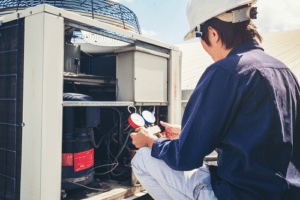System Comparison: Chilled Beams vs Traditional Choices of AC for Commercial Businesses
 Businesses have had numerous solutions for their heating and cooling needs over the years. Often, changes occur incrementally as improved technologies can eke out a system that provides AC for commercial organizations that is a little more efficient. Chilled beam technology is not one of those incremental changes. Instead, it is a distinct way to cool a building that reflects the latest developments in commercial cooling technology.
Businesses have had numerous solutions for their heating and cooling needs over the years. Often, changes occur incrementally as improved technologies can eke out a system that provides AC for commercial organizations that is a little more efficient. Chilled beam technology is not one of those incremental changes. Instead, it is a distinct way to cool a building that reflects the latest developments in commercial cooling technology.
To get a better understanding of what this change represents, we’ll first review some current approaches to managing air conditioning for businesses. Then, we’ll highlight the method and advantages of chilled beams. Finally, we’ll overview the primary considerations to bear in mind to help you choose the correct system for your business.
Standard Approaches to AC in a Commercial Setting
Currently, most businesses employ one or the other of a split system or Variable Refrigerant Flow (VRF) system. The split systems tend to be the most affordable to install, though they tend to take up a lot of space on the exterior of your building. They run refrigerant between your building’s interior and exterior, expelling hot air from your building and cooling a mixture of indoor and outdoor air. This mixture keeps the air pressure consistent while cooling the interior of your building.
VRF systems can be more expensive to install but are easier to work with and less disruptive to your business during installation. There are two alternatives for VRF systems: heat pumps and heat recovery. Heat pumps offer uniform heating or cooling functions throughout the building, while heat recovery systems have more finesse. Unlike heat pump systems, heat recovery allows you to heat or cool different rooms according to individual controls.
Chilled Beams: A New Solution to Provide AC for Commercial Firms
As an alternative to these conventional approaches to AC in commercial businesses, we turn now to chilled beams. This method represents a substantial change to the way that you can handle your air conditioning and is an eco-friendly development. Now, you can cool your building without incurring significant energy costs, even during hotter weather.
The way that this system works is similar in concept to a floor-based radiant heat system, except inverted. In chilled beams systems, pipes of water pass through a beam just below the ceiling. These pipes use cold water to chill the air around them to manage the room’s temperature. Within this category, there are two variations: passive and active. Both varieties generally achieve the same degree of results, but one may be better suited to your building than the other.
The passive chilled beam system uses the same approach as radiant heat or takes advantage of a ventilation system to keep air flowing in the room. This variation uses significantly less energy as commensurate heating systems, and the result is a commercial cooling system that uses less equipment to accomplish as much cooling as another more energy-expensive system. The active version incorporates fins to spread the air more rapidly and can even include exterior air in the cooling mix.
Distinguishing Between These Systems for Your Business
It’s one thing to compare these systems on paper and without context, but another entirely to consider them for your business. Your business has unique cooling needs, budgetary options, and physical constraints. Consider several of the following points:
- Chilled beams are most effective in larger rooms, so they shine in warehouses, department stores, and large workspaces. In tighter spaces, split systems tend to perform quite well, as they can promptly and effectively get the cool air to each room individually.
- Energy efficiency will play less of a role in determining your utility costs if you have minimal temperature variance and do not need to keep your system on constantly. Thus, in temperate climates or businesses that have less of a need to stay cool, you may not see a significant difference in operating cost between the different kinds of systems and should opt for a swifter installation as with a VRF system.
- If you need your system to provide heating during cooler months, chilled beams will struggle to satisfy. Thus, you are likely to need supplementary heating solutions in at least the most commonly used rooms.
Selecting the Right System to Provide AC in a Commercial Setting
After reading through this article, you have a better idea of some considerations that go into selecting an air conditioning system. Despite this, there are many variables that are less common, which may impact the type of system that is best suited to your business. We always recommend speaking with a qualified HVAC contractor to get trustworthy advice. After all, the system that handles the AC in your commercial business will be with you for many years, so it’s worth getting an experienced perspective before committing to a decision.

